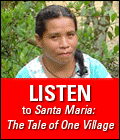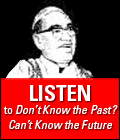 Segment 1:
Santa María: The Tale of One Village
Reporters: Maria Martin, Walter Morgan, And Sam Eaton
Segment 1:
Santa María: The Tale of One Village
Reporters: Maria Martin, Walter Morgan, And Sam Eaton
After the remote Guatemalan village of Santa María Tzejá was viciously sacked by the military in 1982, survivors fled into the surrounding rain forest and eventually to Mexico... some even further, to the United States. Others stayed behind, falling into the military's hands. Today the community is rebuilding with the help of villagers past and present. The story of the village of Santa María Tzejá, embodies the forces and conflicts that define the country today. Our guide for this report is Chilean/American anthropologist Beatriz Manz,who has spent over two decades studying this community. (Beatriz Manz' book: Paradise in Ashes: A Guatemalan Journey of Courage, Terror, and Hope was recently published by University of California Press.)
Note: a second report on Santa María Tzejá airs as segment five.
 Segment 2:
Aftermath: Peace or Pieces – Central America Since the War
Senior reporter: Samuel Eaton
Segment 2:
Aftermath: Peace or Pieces – Central America Since the War
Senior reporter: Samuel Eaton
After the fall of the Soviet Union, international interest in Central America came to an abrupt halt. Despite free elections, in many cases, the countries of Central America soon saw their fledgling new democracies tainted by a backlash of political corruption, drug trafficking and crime that still persists today. This segment examines the aftermath of Central America's civil wars, taking us to communities emblematic of the conflicts in El Salvador, Nicaragua, and Guatemala. The report will provide a bridge from the war period to the present looking at the successes and failures of democratization in this increasingly polarized region.
 Segment 3:
Giving the Military the Pink Slip: the Challenges of Demobilizing Central America's Armies
Reported by John Burnett and Alex Avila
Diffusing the culture of military control is proving to be a daunting challenge
in most of Central America. This report will contrast the persistent bitterness
between military and government in Nicaragua with the relatively small, but
landmark reduction in the military being taken in Guatemala. The report finds
that the new modus operandi for many in the armed forces is making money through
organized crime„thus creating a new form of terror and instability for the
country's citizens, many still haunted by the military's wartime tactics.
Segment 3:
Giving the Military the Pink Slip: the Challenges of Demobilizing Central America's Armies
Reported by John Burnett and Alex Avila
Diffusing the culture of military control is proving to be a daunting challenge
in most of Central America. This report will contrast the persistent bitterness
between military and government in Nicaragua with the relatively small, but
landmark reduction in the military being taken in Guatemala. The report finds
that the new modus operandi for many in the armed forces is making money through
organized crime„thus creating a new form of terror and instability for the
country's citizens, many still haunted by the military's wartime tactics.
 Segment 4:
"La Otra Frontera: The Other Border" – Central America/Mexico Border
Senior Reporter: Franc Contreras
Associate: Citlali Saenz
Segment 4:
"La Otra Frontera: The Other Border" – Central America/Mexico Border
Senior Reporter: Franc Contreras
Associate: Citlali Saenz
As resources flood to Mexico's heavily guarded, northern border with the United States, its southern boundary has become a lawless hinterland. Hundreds of Central American's raft and wade freely across the Suchiate River from Guatemala into Mexico every day only to be met by corrupt officials demanding bribes. There they risk robbery, rape and even murder at the hands of vicious Central American gangs (gangs killed 70 migrants last year). An increased police presence at this "other border" has done little to stem the tide of what some have called the "kamikazes of poverty." This segment will examine the plight of the Central American migrant and the extreme risks he or she is willing to take for the promise of a better life in "El Norte."
 Segment 5:
Santa María Tzejá: Youth Voices(A Tale of One Village, Part 2)
Reporters: Maria Martin, Sam Eaton, Walter Morgan
Youth Associate: Estela Hernandez (from Santa María Tzejá)
Segment 5:
Santa María Tzejá: Youth Voices(A Tale of One Village, Part 2)
Reporters: Maria Martin, Sam Eaton, Walter Morgan
Youth Associate: Estela Hernandez (from Santa María Tzejá)
This report follows the hopes and dreams of the young people of the Guatemalan village of Santa Maria Tzeja, torn apart by war and dislocation. Now the village is trying to make a new life, and its hope is its young people. But in a country where the rate of poverty is over eighty percent, and a region where the majority of the population is under the age of nineteen, the future holds many challenges.
 Segment 6:
Don't Know the Past? Can't Know the Future
Senior Reporter: Richard Gonzales
Associate: Ruxandra Guidi
Segment 6:
Don't Know the Past? Can't Know the Future
Senior Reporter: Richard Gonzales
Associate: Ruxandra Guidi
What drives an entire region into decades of civil war? The debate over conflicting answers to this question directed U.S, foreign policy in the region during the years of civil war in Central America. Interviews with former members of the Reagan administration, analysts, and Central Americans provide an insider perspective. This segment also delves deeper, providing an historical context for those conflicts; the backdrop for understanding the social and political realities of today.
 Segment 7:
Women, Identity, Politics and Power in Today's Central America
Senior Reporter: Maria Hinojosa
Associate: Michele Garcia
Central American Associate: Vilma
Segment 7:
Women, Identity, Politics and Power in Today's Central America
Senior Reporter: Maria Hinojosa
Associate: Michele Garcia
Central American Associate: Vilma
The two decades since the time of heavy conflict in the region have seen profound changes in the role of women. Many women who lost brothers, fathers, or husbands in the fighting were compelled to take on more responsibility. This social dynamic can be seen in the number of women who have entered politics and have taken on leadership positions - from former Nicaraguan president Violeta Chamorro to indigenous rights leader and Nobel Peace Prize winner Rigoberta Menchu. The project's reporters traveled to El Salvador to document the lives of the people in the small village of Santa Marta, near the Nicaraguan border in the decade since the Salvadoran Peace Accords allowed them to return to their homes. They also spoke to women who supported opposing sides during the war, to bring us a compelling picture of the realities and challenges facing women in present day Central America.
 Segment 8:
"¿Todas Las Voces?: Media After the Peace–Community Radio In Guatemala,
Nicaragua and El Salvador
Senior Reporter: Maria Martin
Associates: Maria Flores, Luciana Castro
Central American Associate: Humberto Rodas
Segment 8:
"¿Todas Las Voces?: Media After the Peace–Community Radio In Guatemala,
Nicaragua and El Salvador
Senior Reporter: Maria Martin
Associates: Maria Flores, Luciana Castro
Central American Associate: Humberto Rodas
After decades of exclusion from the mass media in their countries, indigenous people and other rural campesinos in Central America are beginning to gain access to the media, especially through the medium of community radio. So perhaps it is no surprise that in negotiating the 1996 Guatemalan peace accords, the Mayan intellectual Demetri Cojti Cuxil made this demand: "...each Maya community must be able to organize its own radio station, and participate in television production." Our report looks at progress made in this direction over the last six years in both El Salvador and Guatemala - including the flourishing of hundreds of pirate Mayan language community and religious stations, as well as barriers to media access.
 Segment 9:
"Los Homies" - Central American Youth And The Gang Phenomenon
(This Segment also a Collaboration with Youth Radio's International Youth Reporting Project
with National Geographic)
Senior Reporter: Mandalit del Barco
Associates: Ruxandra Guidi, Sarah Bush
Segment 9:
"Los Homies" - Central American Youth And The Gang Phenomenon
(This Segment also a Collaboration with Youth Radio's International Youth Reporting Project
with National Geographic)
Senior Reporter: Mandalit del Barco
Associates: Ruxandra Guidi, Sarah Bush
"Gang violence in Central America is often gruesome -- dismembered bodies, terrifying drive-by shootings in broad daylight, in a few extreme cases, families hacked to death. They are tell-tale signs of one of the most troubling legacies of the decades of civil war and government repression in Central America, a sign of the extent of the damage done to a generation of youth born in the midst of that era -- the spread of violent gangs throughout the region."
The gang problem is being fed by many factors, including: family dislocation caused by war with the inevitable consequence of internal displacement and a huge population of refugees that left their countries never to return; a harsh economic environment with persistent unemployment that has caused millions of people to leave their countries, heading north in search of work and a paycheck to help their families survive back home; and, as fuel for the fire, new US immigration policies that have brought about the deportation from the US of hundreds of thousands of "criminal aliens" who have overwhelmed the legal systems of Central American and other impoverished countries. In many cases, the deportees came to the US with their families when they were babies or young children and know nothing of the countries from which they come. They are sent back to an experience of profound alienation, isolation, and loneliness, often turning to gangs for protection or even a sense of family.
This story will be told in two parts: the first a documentary report on the rise of the gang phenomenon in Central America, and its U.S. connections. The second is a first person narrative report by a young Central American former gang member.
(Information from a report by the Religious Task Force on Central America and Mexico)
 Segment 10:
Indigenous Identity and Expression in Post War Central America
Senior Producer: Maria Emilia Martin
Associates: Summer Harlow, Luciana Castro
Central American Youth Collaborator: Casimira Herrera Xiloj
Segment 10:
Indigenous Identity and Expression in Post War Central America
Senior Producer: Maria Emilia Martin
Associates: Summer Harlow, Luciana Castro
Central American Youth Collaborator: Casimira Herrera Xiloj
In this segment, young indigenous woman Maria Casimira Xejuc Herrera tells her stories about being an indigenous woman in present day Guatemala. Her story is woven with other scenes providing information of what it is like to be an indigenous young person in Central America in the 21st century. We also hear from indigenous leaders othe reality of persistent racism and the possibilities of change.
 Segment 11:
Challenges To Free Expression In 21st Century Central America
Reporter: Maria Emilia Martin
Segment 11:
Challenges To Free Expression In 21st Century Central America
Reporter: Maria Emilia Martin
When Guatemalan journalist Jose Ruben Zamora reported links between the current government and a corrupt mafia involved in narcotics trafficking, kidnapping and extortion, Zamora himself became a target of violence.
This segment follows Zamora's case, in which his work has made him a target of government harassment for several years, and more recently (June 2003), of a brutal attack on him and his family. Our report uses his case to examine the challenges to a free press and the limits of investigative journalism in a society in which increasingly the mechanisms of democracy-- the judicial and legislative system, state-run media, and security systems-- answer to corrupt interests.
 Segments 12:
Conclusion: As told through the perspectives of
Central American Artists, Musicians and Writers
Segments 12:
Conclusion: As told through the perspectives of
Central American Artists, Musicians and Writers
This segment uses the (spoken) written words of past and current Central American writers to give the listener a unique perspective into the Central American experience, both in the region and in this country. The segment (which may be in two parts) will also employ Central American music (from ancient Maya music to current indigenous songs, to traditional music from the region to Central American rock en español) as well as interviews with musicians to produce a rich, and textured segment.
For more information, contact:
Producer Maria Martin email: radioperiodista@gmail.com
or telephone: 512.707.7030 (Texas) or 011.502.832.7066 (Guatemala);
or visit www.creativepublicity.com.
Funded by
![]()
and the Fund for Investigative Journalism.
Photo at top left © 2004 Donna DeCesare www.donnadecesare.com



